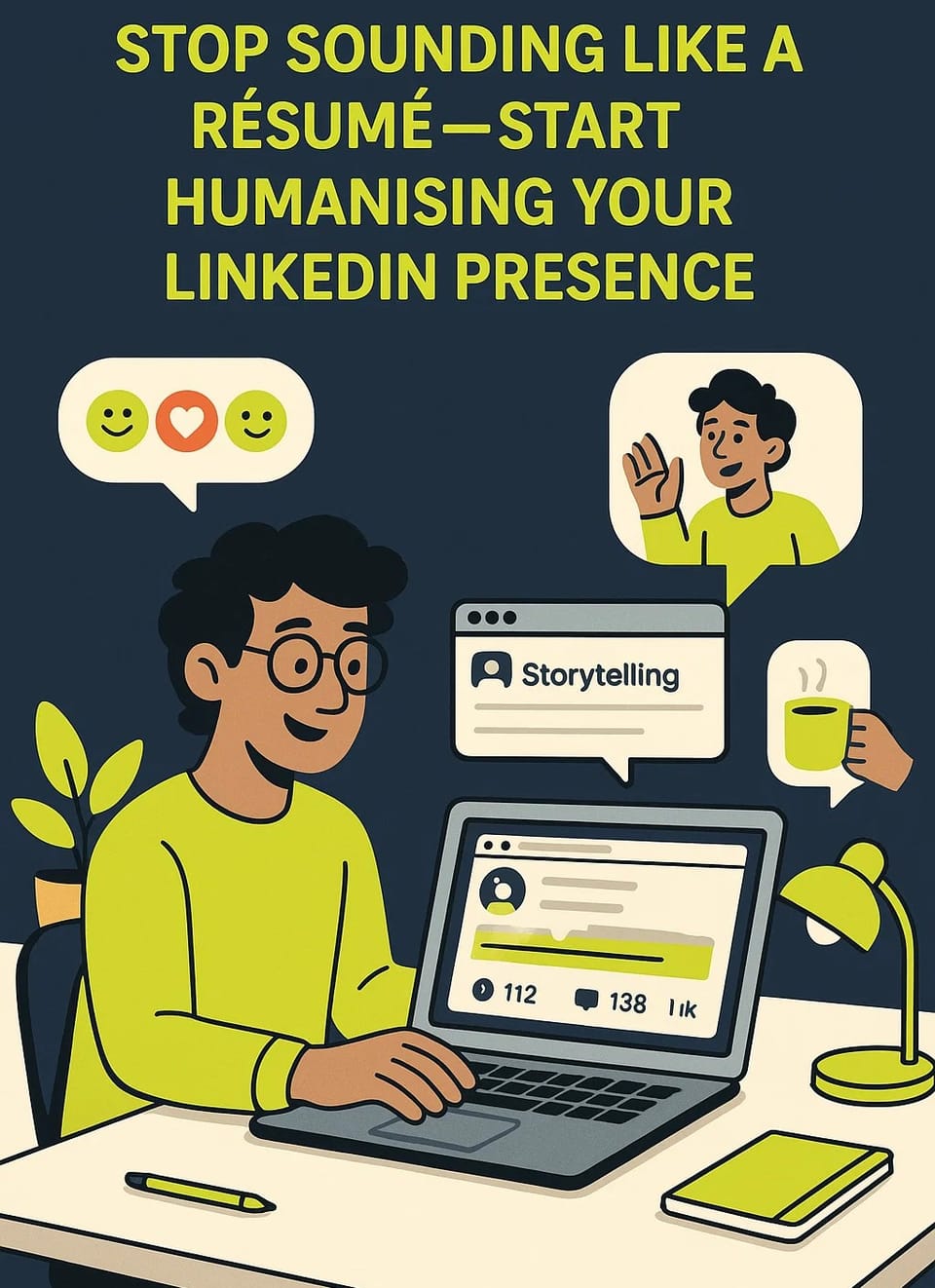Intro: LinkedIn Isn’t a CV—It’s a Cocktail Party (with Wi-Fi)
Sarah runs a £2M marketing budget. She also posts about burning breakfast, her kid's terrible knock-knock jokes, and why she cried during a Zoom call last Tuesday.
Her engagement rate? 10x higher than her competitors, who only share "industry insights" and "thought leadership."
Here's what's wild: The most successful professionals on LinkedIn right now aren't the ones with the most polished posts. They're the ones brave enough to be human in a sea of corporate speak.
While everyone else is optimizing for "professional presence," the real winners are sharing their Monday morning coffee disasters alongside their quarterly wins.
Your LinkedIn isn't your CV. It's your personality with a professional filter—and that filter should be pretty thin.
From Robotic to Relatable
So, what changed?
LinkedIn’s 2025 algorithm now evaluates content for originality, emotional tone, and conversational cues. According to a Q2 2025 update, engagement from first-degree connections now weighs less than conversation starters and comment threads that sound human.
That means resume-speak is out. Relatability is in.
Once Upon a Timeline
Back in the early LinkedIn days, your profile was essentially a digital resume: static, formal, and painfully polite. Fast forward to today, and it’s a content hub, a stage, and—when done right—a magnetic extension of your personality.
Users now expect story-driven posts, offbeat reflections, and even vulnerability. Sharing the lessons behind your promotions matters more than listing them.
The Algorithm's Taste Test: What Makes a Post 'Human' in 2025?
LinkedIn’s feed doesn’t just prioritize high engagement—it prioritizes how that engagement unfolds. Posts are now ranked by:
- Conversational tone: First-person writing and informal phrasing
- Narrative structure: Posts with a hook, story arc, and takeaway
- Real-life context: Personal anecdotes and lived experience
- Comment depth: Threads with meaningful back-and-forth
That’s why a slightly messy, honest post about career burnout will outperform a polished “Top 5 Productivity Hacks” list every time.
Want to optimize your visibility while staying real? Check out Commentify’s LinkedIn Engagement Algorithm Breakdown.
The ‘No One Cares About Your Job Title’ Era
Here’s the hard truth: your job title isn’t what hooks people anymore.
What does?
- What you’ve learned from your job
- What surprised you about your role
- What you struggled with and figured out
Think of your LinkedIn presence as less “Here’s what I’ve done,” and more “Here’s what I’ve been through.” You’re not pitching a résumé. You’re telling a story—with you as the main character.
Plot Twist: How to Make Your LinkedIn Presence Actually Feel Like You
Start with voice. No, not a branding framework—your actual voice. If you wouldn’t say it out loud in conversation, don’t post it.
Want to test it? Read your draft out loud. If it sounds like a brochure, start over.
Better yet:
- Write like you text your closest colleague
- Add weird, specific references (your audience will love them)
- Use emojis sparingly—but strategically—to signal tone
Example: “Closed the quarter at 120%.” Meh.
Better: “Hit 120% of quota and still managed to forget my coworker’s birthday. Balance, right? 🫠”
Less Perfect, More Personal
Vulnerability isn’t oversharing. It’s relatability. You don’t need to bare your soul—just share your process.
Instead of: “I launched a successful campaign.” Try: “I second-guessed every step of this campaign… but it worked. Here’s what surprised me.”
Posts that feel like advice between peers perform better than guru-speak. Share what you're learning—not just what you know.
For creators looking to grow under LinkedIn’s tighter interaction filters, see Commentify’s post on LinkedIn Growth with Restricted Engagement.
The Human-AI Tag Team
Can AI help? Yes—but only if you drive.
The best creators are now using AI tools to:
- Organize ideas
- Draft outlines
- Find content gaps
Then, they inject their own tone, perspective, and storytelling.
This isn’t about rejecting AI—it’s about resisting the default AI tone. It’s beige. You’re not.
The future? Hybrid content. Human-authored but AI-assisted. Think:
- Human tone, machine precision
- Consistency at scale, uniqueness per post
- Auto-commenting tools that sound like you, not a bot farm
Speaking of which: Commentify lets you auto-comment on high-value posts using tailored, on-brand replies. So your voice shows up, even when your calendar’s stacked.
Conclusion: Be More You, Less LinkedIn-Legacy
The professional world is ready for nuance. For warmth. For less polish and more perspective.
So next time you post, ask yourself:
- Would I read this if someone else posted it?
- Does this sound like me?
- Is there a real story here—or just a status update?
LinkedIn isn’t your résumé—it’s your narrative.
And if you're scaling your commenting game without sounding like a spammy AI clone, Commentify.co can help you stay visible, relevant, and real—one human-sounding comment at a time.

